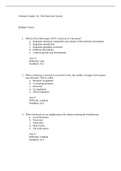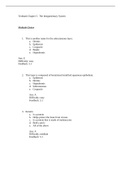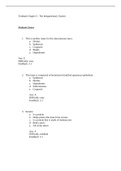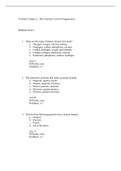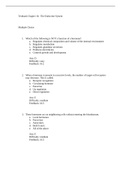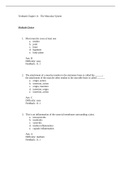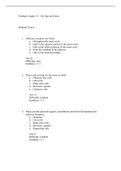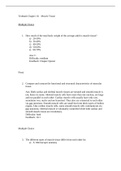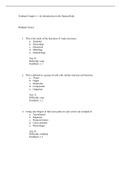University of Toledo
Latest uploads at University of Toledo. Looking for notes at University of Toledo? We have lots of notes, study guides and study notes available for your school.
-
103
- 0
-
11
All courses for University of Toledo
Latest notes & summaries University of Toledo
Multiple Choice 1. Which of the following is NOT a function of a hormone? a. Regulates chemical composition and volume of the internal environment b. Regulates metabolism c. Regulates glandular secretions d. Produces electrolytes e. Controls growth and development Ans: D Difficulty: easy Feedback: 18.2 2. When a hormone is present in excessive levels, the number of target-cell receptors may decrease. This is called: a. Receptor recognition b. Circulating hormone c. Paracrine d. Up regulation e. ...
1. This is another name for the subcutaneous layer. a. Dermis b. Epidermis c. Corpuscle d. Basale e. Hypodermis Ans: E Difficulty: easy Feedback: 5.1 2. This layer is composed of keratinized stratified squamous epithelium. a. Epidermis b. Dermis c. Hypodermis d. Subcutaneous e. Corpuscle Ans: A Difficulty: easy Feedback: 5.1 3. Keratin a. Is a protein b. Helps protect the bone from viruses c. Is a protein that is made of melanocytes d. Both a and c e. All of the above Ans...
1. This is another name for the subcutaneous layer. a. Dermis b. Epidermis c. Corpuscle d. Basale e. Hypodermis Ans: E Difficulty: easy Feedback: 5.1 2. This layer is composed of keratinized stratified squamous epithelium. a. Epidermis b. Dermis c. Hypodermis d. Subcutaneous e. Corpuscle Ans: A Difficulty: easy Feedback: 5.1 3. Keratin a. Is a protein b. Helps protect the bone from viruses c. Is a protein that is made of melanocytes d. Both a and c e. All of the above Ans...
1. What are the major elements found in the body? a. Nitrogen, oxygen, calcium, sodium b. Hydrogen, carbon, phosphorus, calcium c. Carbon, hydrogen, oxygen and nitrogen d. Oxygen, nitrogen, potassium, calcium e. Potassium, phosphorus, sodium, hydrogen Ans: C Difficulty: easy Feedback: 2.1 2. The subatomic particles that make up atoms include: a. Neutrons, quarks, muons b. Protons, neutrons, electrons c. Muons, positons, neutrons d. Electrons, quarks, protons e. Positons, protons, n...
. Which of the following is not a function of the nervous system? a. Sensory function b. Integrative function c. Motor function d. All are functions of the nervous system Ans: D Level: easy Link: 12.1 2. The peripheral nervous system can be divided into: a. Somatic nervous system b. Autonomic nervous system c. Enteric nervous system d. All of the above Ans: D Level: easy Link: 12.3 3. The motor portion of the autonomic nervous system can be divided into: a. Sympathetic division ...
Multiple Choice 1. Which of the following is NOT a function of a hormone? a. Regulates chemical composition and volume of the internal environment b. Regulates metabolism c. Regulates glandular secretions d. Produces electrolytes e. Controls growth and development Ans: D Difficulty: easy Feedback: 18.2 2. When a hormone is present in excessive levels, the number of target-cell receptors may decrease. This is called: a. Receptor recognition b. Circulating hormone c. Paracrine d. Up...
. Most muscles cross at least one a. tendon b. joint c. bone d. ligament e. body plane Ans: B Difficulty: easy Feedback: 11.1 2. The attachment of a muscles tendon to the stationary bone is called the ______; the attachment of the muscles other tendon to the movable bone is called ______. a. origin, action b. insertion, action c. origin, insertion d. insertion, origin e. insertion, action Ans: C Difficulty: easy Feedback: 11.1 3. This is an inflammation of the synovial membran...
Testbank Chapter 17. The Special Senses Multiple Choice 1. Olfactory receptors are found a. Throughout the nasal cavity b. Only in the superior portion of the nasal cavity c. Only in the inferior portion of the nasal cavity d. From the vestibule to the pharynx e. Only in the mid-nasal ridges Ans: B Difficulty: easy Feedback: 17.1 2. These cells provide for the sense of smell. a. Olfactory hair cells b. Glial cells c. Basal stem cells d. Bowman’s glands e. Gustatory cells Ans: ...
1. How much of the total body weight of the average adult is muscle tissue? a) 20-30% b) 30-40% c) 40-50% d) 50-60% e) 60-70% Ans: C Difficulty: medium Feedback: Chapter Opener Essay 2. Compare and contrast the functional and structural characteristics of muscular tissue. Ans: Both cardiac and skeletal muscle tissues are striated and smooth muscle is not, hence its name. Skeletal muscle cells have more than one nucleus, are large and run parallel to each other. Cardiac muscle cells...
Testbank Chapter 1. An Introduction to the Human Body Multiple Choice 1. This is the study of the functions of body structures. a. Anatomy b. Physiology c. Dissection d. Histology e. Immunology Ans: B Difficulty: easy Feedback: 1.1 2. This is defined as a group of cells with similar structure and function. a. Tissue b. Organ c. Molecules d. Compounds e. Organism Ans: A Difficulty: easy Feedback: 1.2 3. Using your fingers to find your pulse on your wrist is an example of a. A...

